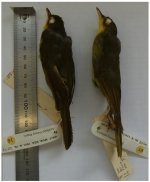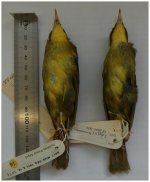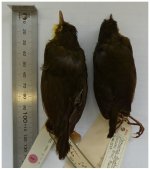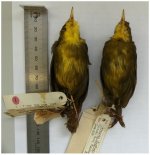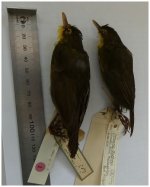I guess most reading this will have read some or all of the 3 web post extracts I paste below. If not, do take a look. I don't think we should underestimate just how little is known about this species or how 'dubious' are most recent reports... Absolutely no disrespect intended to any of the 3 birders mentioned, in fact, quite the opposite.
Pam's site is now visited regularly for Slender-billed Flufftail and has huge potential. Others may be able to add more on what's been seen there recently...? I believe Patrice is a very well-known and experienced guide.
Loads of birders have visited Masoala and the fact that DT hasn't been nailed there tells a story to me.
Marojejy sounds intriguing.
Have dropped a note to Tring asking about skins but I'm not expecting a quick (or perhaps any!) reply. Not sure they have time to deal with very informal questions like mine.
My hope is that DTs are out there and once discovered, they will turn out to be a 'you-know-it-when-you-see-it' bird.
Cheers all,
Andy.
Pamela C. Rasmussen
2 Jun 2008
Andasibe-Mantadia National Park, Mantadia
ID by guide Patrice, who saw well at close quarters and said he was certain of this ID particularly on the basis of calls; I saw it poorly in dim light and could not distinguish from Xanthomixis zosterops. Call does not closely match any for X. zosterops on any CD or XC, being distinctly lower (mainly 5.5-7.5 kHz, with a few notes higher) and sharper and clearer. However, not similar to only available cut, on Bird Sounds of Madagascar, for this species.
Johannes Fischer,
November 2012
Due to flight schedules we had to visit the far-flung Marojejy National Park. This park was of special interest to me for rumours about genuine Dusky Tetraka´s seen here. Unfortunately these rumours turned out to be false and we saw none of these mythical creatures. However, I still think this is The place to search for this phantom, due to the variety of the forests and the extremely high quality of them in this national park.
Chris Kehoe, Birdquest
Oct / Nov 2013
We began our final day at the Masoala with an early return to the trails near Ambodiforaha where a Redfronted Coua showed very well. We struggled with a furtive Tetraka that our local guide was convinced was a rare Dusky Tetraka though ultimately it was not fully convincing (the local form of Spectacled Tetraka looks just like the illustration of Dusky Tetraka in the fieldguide!) and watched a small feeding party containing Tylas Vangas, Madagascar Paradise Flycatchers, Malagasy Green Sunbird and others.







